
The church that would become the Basilica-Cathedral Notre-Dame de Québec was first erected in 1647. It became the first parish church north of the Spanish colonies, when the parish was established in 1664. Ten years later, it became the first cathedral in New France, the seat of the bishop, François de Laval, who became the first Canadian bishop. The church received the title of basilica by Pope Pius IX in 1874, an acknowledgement of its importance as a place of pilgrimage.
Finally, another honor was bestowed on Notre-Dame de Québec in 2014, when Pope Benedict XVI allowed the installation of the only Holy Door outside of Europe.
The present building houses several remnants of its past history. For example, the imposing columns found on each side of the central nave are vestiges of previous walls of the initial building, kept to better support the whole, more recent construction.
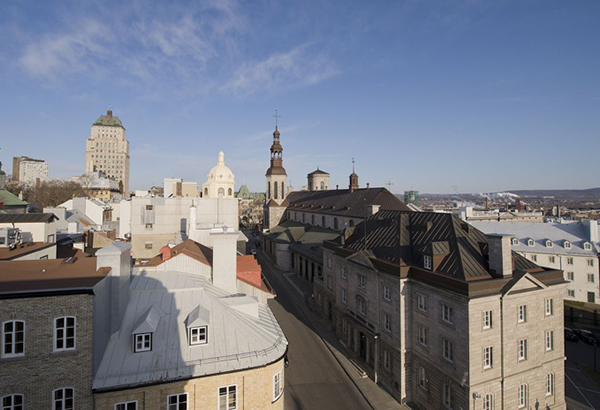
The walls of the Basilica-Cathedral are visible signs of a long and continuous history of renovations and reconstruction. Initial work began in 1647 and the first Mass was celebrated in 1650. It was enlarged in 1749, but, less than ten years later, it was destroyed by cannon balls during the siege of the city by British troops in 1759.
The landing of British troops had a deep intact on the esthetic choices that influenced the interior decoration of Notre-Dame de Québec. For instance, a flamboyant ornamentation was installed in the sanctuary of the Basilica, particularly a golden baldaquin topped by a triumphant and glorious figure of Christ, victorious over death, a clear symbol of a vanquished people called to survive the defeat it endured in 1759. Finally, nearly a century later, in 1922, the Basilica cathedral was once again ravaged by a fire that left only the exterior walls standing, with the bells also surviving the disaster. The church was rebuilt with a metal framework and with a great care to reproduce as faithfully as possible the previous interior décor. This was made possible by taking into account many surviving original photos and designs.
Several elements of the décor should be noted. First of all, the main altar is inspired by the design of Saint Peter in Rome. This liturgical piece of furniture, the work of Baillargé, is a perfect reproduction of the original. The gilding was realized by the very skilled Ursuline nuns, who specialized in this craft. Another nun, Sister Marie Elmina Lefebvre, a member of the community of the Sisters of Charity, painted the spectacular rendition of the Immaculate Conception, a copy of the Lebrun work, which disappeared in the fire.
In the sanctuary, one can also admire the cathedra, in the front, to the right. It is the massive and splendid chair of the local bishop, decorated with his coat of arms; and on the crown of the episcopal throne, those of the Archdiocese of Quebec.
Another element worthy of attention is the bench of the trustees, above which can be found the Assumption of Mary, arms extended and carried to heaven by angels. This unique bench was only used by the members of the parish council responsible for its administration. It is located in front of the pulpit so the trustees could hear clearly the preaching given by the priest. Finally, to conclude this brief survey, all around the church can be found splendid stained-glass windows depicting the life of the Virgin Mary.
Information taken from Denyse Légarée, L’inspirante Basilique-cathédrale, l’architecture de Notre-Dame de Québec, Septentrion, Québec, 2014.
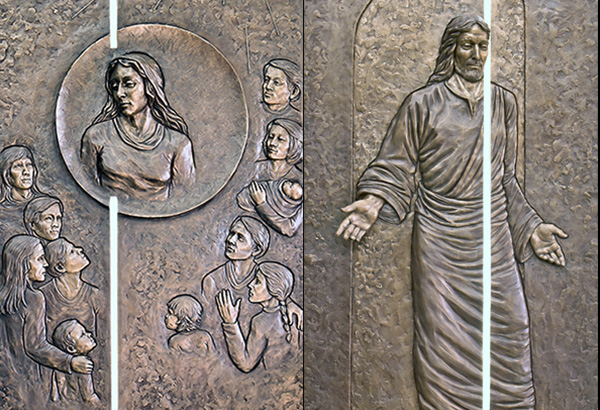
Pierced in the wall of the Holy Heart Chapel, located on the northern side of the church, the Holy Door was inaugurated on December 8th, 2013.
It is the first Holy Door outside of Europe, and the seventh in the world. Four can be found in Rome, one in Ars, France, and one in Compostello, Spain.
Having such a door is an extraordinary privilege granted by the Holy See to the first Catholic parish of America north of the Spanish colonies. Jules Lasalle, the sculptor, translated the message intended. On the outer face of the door, he fashioned the figure of a welcoming Christ, Himself the door allowing the faithful to enter the Kingdom of God. On the inner side, leading to the chapel, the Virgin Mary is surrounded by believers. The luminous cross seen through the door recalls an immaterial passage just like the natural light it lets trhough.
Information taken from Denyse Légarée, L’inspirante Basilique-cathédrale, l’architecture de Notre-Dame de Québec, Septentrion, Québec, 2014.
The Holy Door allows one to enter the Sacred heart Chapel where is displayed the great reliquary of the saints and blessed of Canada.
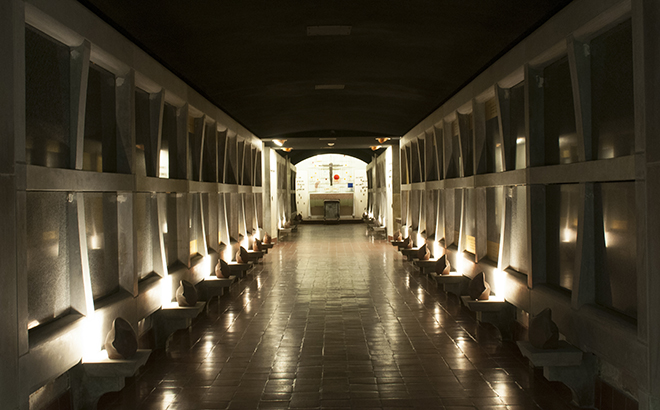
Burials took place here between 1654 and 1898. More than 900 deceased persons rest beneath the cathedral. Four governors of New France were brought here after the burning of the Recollects Chapel in 1796.
This crypt was arranged under the cathedral during the reconstruction in 1923. It was enlarged later in order to accommodate all the bishops and archbishops of the diocese of Quebec. The floor of the Holy Family Chapel (Centre d’animation François-De Laval) was opened and a large and deep ditch was excavated to access the crypt, which opened in 1959. Most of the bishops and archbishops of Quebec rest in funereal recesses, except the second bishop of Quebec, Jean-Baptiste de la Croix de Chevrières de Saint Vallier (1653-1727), whose remains can be found in the chapel of the General Hospital of Quebec, which he founded. Two others French bishops are buried in Paris.
Information taken from Denyse Légarée, L’inspirante Basilique-cathédrale, l’architecture de Notre-Dame de Québec, Septentrion, Québec, 2014.
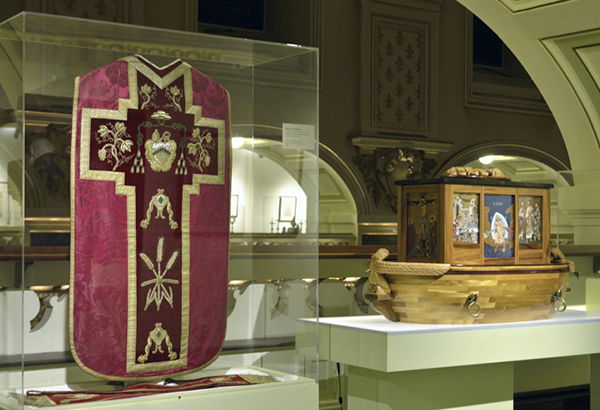
On the occasion of the 350th anniversary of the parish of Notre-Dame de Québec in 2014, the side galleries were arranged to become a museum where is exposed the exceptional treasure of the Basilica-Cathedral. It offers a unique occasion to discover liturgical vestments, liturgical silverware from the French era, and several paintings that decorated the church until 1990.
Information taken from Denyse Légarée, L’inspirante Basilique-cathédrale, l’architecture de Notre-Dame de Québec, Septentrion, Québec, 2014.
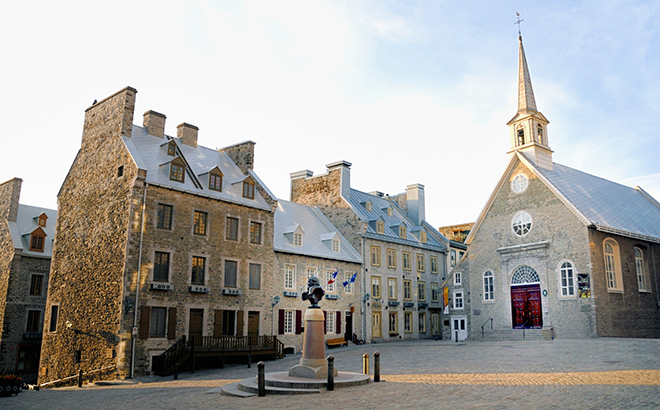
Unavoidably, if we talk about the Basilica-Cathedral, one must also present the small but lovely Notre-Dame-des-Victoires church, located at the foot of the hill in the Petit Champlain neighbourhood, close to the St. Lawrence River. Initially, it is Saint François de Laval himself who wished the church to be built, as an extension of the cathedral. This way, the elderly faithful of the lower town did not have to ascend the steep hill to go to Mass. It is first called the Enfant-Jésus church (of the Child Jesus).
Major events brought changes to the name of the church. First of all, in 1690, a British fleet arrived in Quebec. Frontenac, its governor at the time, was ordered to give up the city to the invaders. His answer has remained famous to this day: “I will answer you with the mouth of my cannons.” Incapable of landing properly, the British forces departed swiftly.
To honor this event, the church is rebaptized Notre-Dame-de-la-Victoire (of the Victory), that same year 1690. Again, in 1711, it was renamed Notre-Dame-des-Victoires (of the Victories) to celebrate the destruction of the fleet of Admiral Walker, sent to attack Quebec, during a violent storm on the St. Lawrence River.
Notre-Dame-des-Victoires, erected in 1688, is the oldest stone place of worship to be found in Canada. It has always kept its original stone walls throughout its history.
The lovely and popular church has always attracted many pilgrims and tourists, but also film and television directors such as Steven Spielberg.
It remains a busy chapel of devotions and liturgical celebrations to this day.
Information taken from Paul Labrecque, L’Église Notre-Dame-des-Victoires, un monument historique sur la Place Royale à Québec, Septentrion, Québec, 2014.